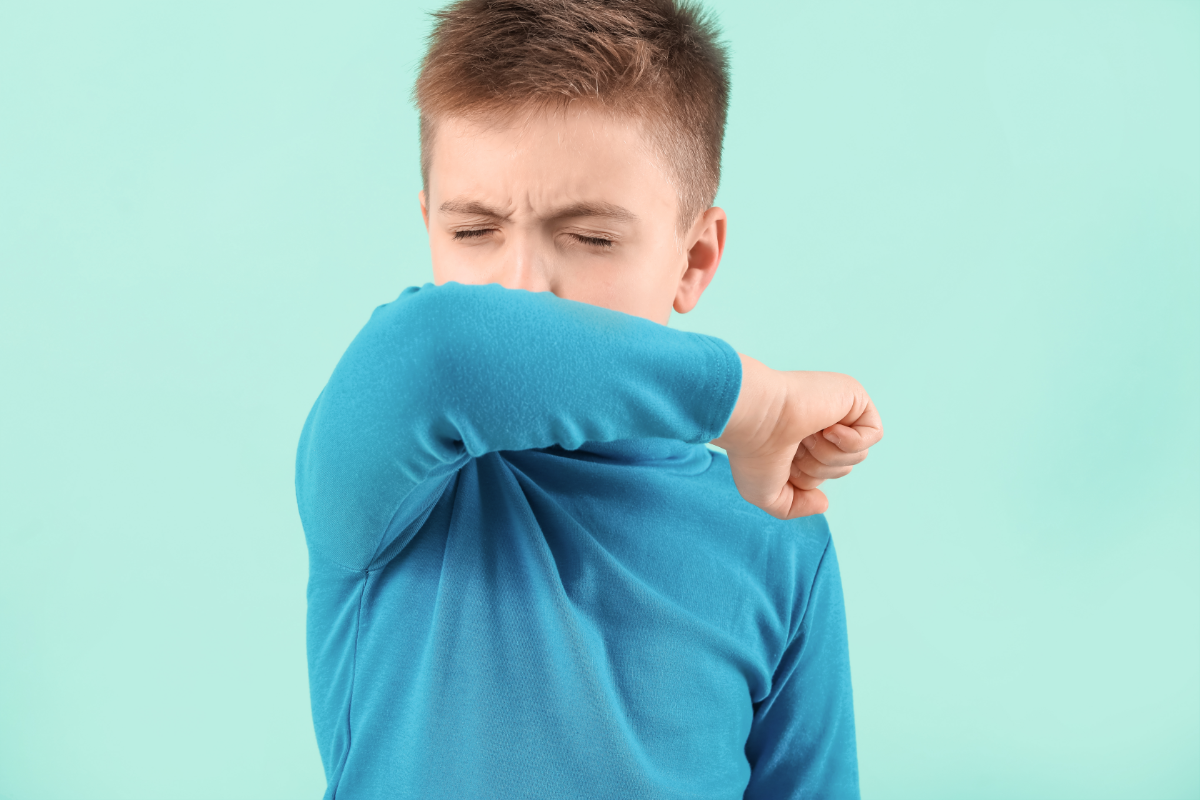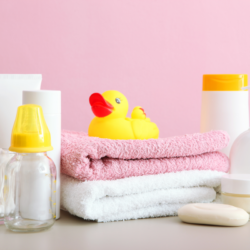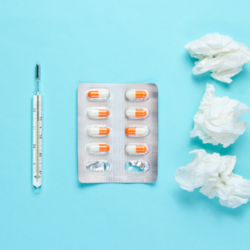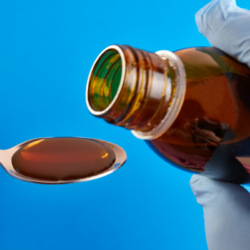[Warning: The information presented in this article on natural treatments for pneumonitis in children, such as probiotics, bramble bud macerates, and essential oil chest balms, is provided for information purposes only and should not be considered a substitute for professional medical advice. Lung disease, particularly in children, requires accurate diagnosis and appropriate care by qualified health professionals. Although these natural approaches can be complementary to medical treatment, they should only be used after consultation with and recommendation by a healthcare professional. The information contained in this article is based on scientific knowledge available up to the date of publication and may not reflect the most recent medical advances. It is essential to always consult a doctor or qualified healthcare professional before starting, modifying or stopping any medical treatment. Under no circumstances should the information in this article be used for making a diagnosis or initiating medical treatment]
Faced with a worrying rise in cases of Mycoplasma pneumoniae pneumonia, particularly in China and France, there is a need to raise awareness. This bacterium, known since 1944, mainly targets young people, especially children aged 5 to 10 and adolescents. It is transmitted by droplets excreted when sneezing or coughing, often asymptomatically, making diagnosis tricky without a specific PCR test. (1)
Classic symptoms include a runny nose, cough, sore throat, headache and sometimes a high fever. Although recovery is generally spontaneous, more serious cases may require medical attention, particularly in children.
Against this backdrop, there is a growing interest in effective natural treatments for children, as a complement to conventional medical approaches. Natural strategies, focused on strengthening the body’s resilience and managing symptoms, include sufficient sleep, a healthy diet, moderate physical activity, and specific respiratory health care, such as inhalation of warm humid air and hydration. (2)
This article aims to provide parents and carers with valuable information on how to recognise and effectively manage Mycoplasma pneumoniae pneumonia in children, with an emphasis on proven natural remedies.
Symptoms and diagnosis
Mycoplasma pneum oniae pneumonia manifests itself in a variety of ways in children. Common symptoms include a sore throat, tiredness, fever, persistent cough and headache. Children under 5 may experience symptoms more similar to those of a common cold, such as sneezing, a blocked or runny nose, watery eyes, and sometimes vomiting and diarrhoea. Pneumonia, with fever and chills, cough, tiredness and shortness of breath, can also occur. These symptoms generally appear between 1 and 4 weeks after infection. (3)
Diagnosis of this condition is based on a PCR test, which detects the bacteria in respiratory secretions, providing a specific and reliable method of confirming the presence of Mycoplasma pneumoniae. This diagnostic process is essential for guiding the appropriate and timely management of young patients with pneumonia.
Conventional treatments for Mycoplasma pneumoniae Pneumonia
The treatment of Mycoplasma pneumoniae infections in children is based on the administration of macrolide antibiotics, regardless of the patient’s age. Drugs such as roxithromycin, azithromycin and clarithromycin are commonly prescribed. The duration of use of these antibiotics varies between 5 and 15 days depending on the molecules prescribed, with shorter courses for azithromycin. In the event of macrolide resistance, tetracycline antibiotics can be used from the age of 8, while fluoroquinolones are reserved for adults. In the exceptional case of resistance in children under 8, fluoroquinolones may be used. Antibiotic treatment helps to significantly reduce the duration of the disease. It is not necessary to check for the presence of mycoplasma after treatment, as it may remain detectable for some time, without indicating an active bacterial infection. (4)
Natural remedies to help treat pneumonia in children
In addition to conventional medical treatments prescribed by a health professional, certain natural treatments can be used to help children recover from pneumonia. It is important to note that these approaches in no way replace medical treatment, but can provide additional support to relieve symptoms and promote recovery.
- Probiotics: Probiotics are beneficial micro-organisms that can have a positive effect on the immune system. Studies have shown that consumption of probiotics, such as lactobacilli, can help reduce the incidence of lower respiratory infections, including bronchitis and pneumonia, in children. They may also play a role in preventing hospital-acquired pneumonia in mechanically ventilated patients. It is essential to consult a healthcare professional to determine the appropriate dosage. (5)
- Garlic (Allium sativum): Garlic is traditionally used for its antimicrobial properties. Although its effect on the symptoms of pneumonia has only been tested in a small number of subjects, it can be considered a beneficial dietary supplement. We recommend eating around 4 cloves of fresh garlic a day, or taking 2 g to 4 g of dried garlic, 3 times a day.
- Steam inhalation: Inhaling steam containing plants such as German chamomile, black elderflower or lemon balm can help soothe throat and bronchial irritation, while helping to expel secretions. A specific procedure must be followed for this inhalation.
- Mustard poultice: Applying a mustard poultice to the chest can help relieve pain, reduce fever and help expel mucus. It is important to check the temperature of the poultice to avoid burning. From the age of 15.
- Relaxation techniques: Relaxation, using various methods such as deep breathing, can help reduce muscle tension and promote healing. This can be particularly beneficial for children suffering from chest pain associated with coughing and deep breathing.
- Manual lymph drainage: This gentle massage technique can stimulate lymph circulation, boosting the body’s immune responses. It can also help relieve chest pain and facilitate the elimination of pulmonary secretions in children suffering from pneumonia.
- Bramble bud macerate: Bramble bud macerate, extracted from the young shoots of Rubus fruticosus L., is beneficial for the respiratory system, helping to drain the lungs, particularly in cases of bronchitis or emphysema. It also has a slight oestrogenic effect, making it an interesting choice to accompany the menopause or in cases of uterine fibroids. For children over the age of 3, it can be taken at the rate of one drop a day for every 10 kilograms of body weight, starting with one drop and gradually increasing the dose.
- Chest balms with essential oils:Pranarôm Junior (Aromaforce Baume pectoral Junior) and Comptoir Aroma Kidchest balms offer a natural solution to soothe children during winter ENT infections. They contain organic essential oils such as Eucalyptus radiata, Marjoram, Thyme, Ravintsara, Field Mint, Balsam Fir and Sweet Clover. By gently massaging in these balms, children benefit from their soothing and refreshing properties for improved respiratory comfort, while warding off viral and bacterial infections.
- Homeopathy: Discover our special winter homeopathic kit to boost your children’s immunity and protect them from common cold season ailments. This kit is a fast, effective solution, with no known side effects, to combat the viruses and bacteria responsible for winter ailments such as colds, flu, bronchitis and gastro-enteritis. To combat pain, fever and redness in the throat, think of the winning trio: every hour, give your child 3 granules of Belladonna 9 CH 3 granules of Mercurius Solubilis 9 CH 3 granules of Phytolacca 9 CH.
Mycotherapy in the treatment of pneumonia in children
As part of the drive to boost children’s immune systems, particularly during pandemics and back-to-school periods, mycotherapy is emerging as a natural approach to improving the body’s resistance to respiratory infections, including pneumonitis. Mycotherapy is based on the use of medicinal mushrooms with immunomodulatory properties. (7) (8) (9) (10)
How children’s immune systems work
It is essential to understand that children’s immune systems have different characteristics to those of adults. Up to the age of 6, immunity in children is marked by a certain unpredictability due to the immaturity of their natural defences and detoxification systems. Epithelial barriers, mucus production and other elements essential for protection against infection are still developing in children and young adults.
Mycotherapy: Activating the immune response
Mycotherapy explores the benefits of medicinal mushrooms, such as Reishi, rich in beta-glucans, to stimulate children’s immune systems. Beta-glucans have the ability to stimulate immune cells, in particular B and T lymphocytes, as well as NK (natural killer) cells, which play a crucial role in regulating the immune response. It is therefore advisable to take a preventive cure during high-risk periods (winter season), available in the form of food supplements.
Prebiotics and probiotics for a balanced microbiota
A balanced intestinal microbiota is essential for maintaining robust immunity. Imbalances in the intestinal microbiota can be linked to an increased risk of infections. The use of prebiotics and probiotics can help to balance children’s intestinal microbiota, strengthening their defence against respiratory infections. (6)
Many laboratories specialising in nutritherapy (Pileje, Nutergia, Solaray, etc.) have developed concentrated probiotic formulas, particularly in easy-to-take capsule form. They are recommended on an individual basis according to a number of criteria (eating habits, physical activity, age, etc.).
Recognising the enemy: Symptoms and detection
Finally, it’s crucial to be able to recognise the symptoms of a respiratory infection, such as fever, cough, loss of taste and smell, and other flu-like symptoms. Mycotherapy, combined with a balanced diet, good hygiene and a healthy lifestyle, can help strengthen the body’s ability to recognise and fight pathogens.
Treatment of respiratory tract infections according to Robert Masson
As a naturopath trained by Robert Masson, I strive to take a holistic approach to health, focusing on balance and overall well-being. This approach is particularly relevant in the management of respiratory tract infections in children, where prevention and natural treatment play a key role.
1. The importance of digestion in respiratory health
Robert Masson has always emphasised the close link between digestion and respiratory health. Effective digestion can limit hyperaemia of the stomach mucosa, which is often the cause of ENT and bronchopulmonary infections. Aromatics, such as oregano, thyme, cinnamon, cloves, mint and bay leaf , are not only beneficial for digestion but also inhibit pathogenic intestinal flora. Their increased use in cooking is therefore highly recommended.
2. The role of seafood in preventing respiratory diseases
Children lacking in minerals and trace elements are particularly susceptible to ENT and bronchopulmonary diseases. Seafood naturally provides these essential nutrients. For those who do not eat seafood, our online pharmacy offers a variety of trace elements in liquid form, making them easy to incorporate into the daily diet and helping to modify the biological terrain to reduce infections.
3. Targeted use of essential oils
For respiratory infections, the use of anti-viral and anti-bacterial essential oils can be very effective. For example, our bronchitis and dry cough preparation, made up of cypress,eucalyptus radiata, ravintsara, niaouli and calophylla essential oils, can be applied to the chest and back to relieve symptoms. This formula is specially designed for adults and children over the age of 12.
For younger children, Dr Valnet‘s Babibad Children’s Bath with Essential Oils offers a gentle, natural solution. This aromatic bath, made with 100% ORGANIC essential oils, is ideal for soothing, relaxing and improving sleep in children aged 12 months and over.
Finally, for daily respiratory well-being, Climarome by Dr Valnet, a natural spray with essential oils of lavender, mint, niaouli, thyme and pine, can be used for inhalation or rubbing. This product is particularly suitable for children over 6 and adults.
Mycoplasma pneumoniae pneumonia in children : When nature offers solutions
Mycoplasma pneumoniae pneumonia, which accounts for 10-40% of community-acquired pneumonia in children, is often treated effectively with antibiotics. However, in some cases, these infections become resistant, leading to more severe forms known as resistant mycoplasma pneumonia (RMP).
In the face of this resistance, Chinese herbal medicine (CHM) is proving to be a promising alternative. An in-depth study analysed 17 clinical trials with 1,451 participants, showing that CAM significantly improves the rate of clinical efficacy (11), helping to reduce fever, accelerate the disappearance of cough and lung rales, and reduce inflammation, measured by TNF-α levels. These benefits are attributed to various approaches to CAM, including the elimination of heat-phlegm and toxins, and the promotion of blood circulation.
However, it is important to note that, despite these promising results, further rigorous studies are needed to confirm the effectiveness of CAM in treating PMR in children. The researchers encourage well-designed, double-blind, randomised controlled trials to further evaluate these natural treatments.
Given the increase in cases of PMR, particularly in Asia, PCM offers a glimmer of hope. It represents a potentially effective natural alternative, opening the way to new therapeutic strategies for children’s health.
Advice on the use of natural treatments for children:
When considering the use of natural treatments to help children with Mycoplasma pneumoniae pneumonia, it is essential to take into account certain precautions and advice to ensure their safety and effectiveness. Here are some important recommendations:
- Consult a health professional: Before starting any natural treatment, it is essential to consult a paediatrician or doctor for a precise diagnosis of the pneumonia and advice tailored to the child’s state of health. The professional will also be able to advise you on the appropriate complementary treatments.
- Follow the recommended doses: If you use food supplements or herbal remedies, make sure you strictly follow the doses recommended by the manufacturer or your healthcare professional. Children have specific needs depending on their age and weight, so it’s essential not to overdose.
- Watch for reactions: Be aware of your child’s reactions when using any natural treatment. If side effects or allergies occur, stop the treatment immediately and consult a doctor.
- Adequate hydration: Make sure your child stays well hydrated. Water is essential for keeping the respiratory tract moist and helping to manage symptoms.
- Respect rest: Rest is crucial to recovery. Encourage your child to get enough rest to help their body fight the infection.
- Watch for signs of deterioration: Although most cases of Mycoplasma pneumoniae pneumonia in children resolve spontaneously, it is essential to monitor the child’s condition carefully. If symptoms worsen or if new symptoms appear, consult a healthcare professional immediately.
Preventing pneumonia in children
Preventing pneumonia in children is of vital importance in reducing the risk of infection and promoting optimum respiratory health. Here are some preventive measures to consider:
- Vaccination: Vaccines play an essential role in preventing bacterial pneumonia. Make sure your child is up to date with the recommended vaccines, including those against Streptococcus pneumoniae (pneumococcus) and Haemophilus influenzae type b (Hib). These vaccines can help prevent serious respiratory infections.
- Hygiene: Teaching your children good hygiene practices is fundamental to reducing the transmission of respiratory infections. Encourage them to wash their hands regularly with soap and water, especially before meals and after using the toilet. Use disposable tissues when sneezing or coughing, and teach them to cover their mouth and nose with their elbow to avoid spreading germs.
- Avoid passive smoking: Exposure to tobacco smoke is a major risk factor for respiratory infections in children. Avoid smoking inside the house or car when your child is present, and make sure that areas where he or she spends time are free of tobacco smoke.
- Balanced diet: A healthy, balanced diet helps to strengthen the immune system. Make sure your child eats a diet rich in fruit, vegetables, lean proteins and other essential nutrients to promote overall health.
- Encourage physical activity: Regular exercise can help strengthen your child’s respiratory system. Encourage them to be active, play outdoors and maintain an active lifestyle.
- Avoid contact with people who are ill: When family members or other people are ill, limit your child’s contact with them as much as possible to reduce the risk of transmitting respiratory infections.
- Healthy environment: Make sure your child’s environment is clean and free from moulds or other allergens that can trigger respiratory problems. Good ventilation is also important.
- Breast-feeding: Breast-feeding for the first few months of life can help strengthen your child’s immune system and reduce the risk of respiratory infections.
Preventing pneumonia in children involves a combination of measures, including vaccination, hygiene, diet, exercise and the promotion of a healthy environment. By following this advice, you can help protect your child’s respiratory health and reduce the risk of lung infections. It is also advisable to consult a health professional regularly for personalised advice on preventing respiratory illnesses.
Source:
- https://www.who.int/emergencies/disease-outbreak-news/item/2023-DON494
- https://www.ncbi.nlm.nih.gov/pmc/articles/PMC3286761/
- https://www.la-croix.com/sante/Mycoplasma-pneumoniae-faut-craindre-cette-bacterie-France-2023-11-23-1201291980
- https://draxe.com/health/mycoplasma/
- https://www.cdc.gov/pneumonia/atypical/mycoplasma/about/signs-symptoms.html#:~:text=Children who get Mycoplasma pneumoniae,Headache
- https://www.sfm-microbiologie.org/wp-content/uploads/2019/07/BACTERIE_Mycoplasma_pneumoniae.pdf
- https://www.ncbi.nlm.nih.gov/pmc/articles/PMC6334620/
- https://theconversation.com/gut-reaction-how-the-gut-microbiome-may-influence-the-severity-of-covid-19-139094
- https://pubmed.ncbi.nlm.nih.gov/31777013/
- https://www.ncbi.nlm.nih.gov/pmc/articles/PMC1160565/
- https://www.elsevier.es/es-revista-medicina-universitaria-304-articulo-inmunomoduladores-como-terapia-adyuvante-enfermedad-X1665579609481115
- https://www.frontiersin.org/articles/10.3389/fphar.2021.678631/full





